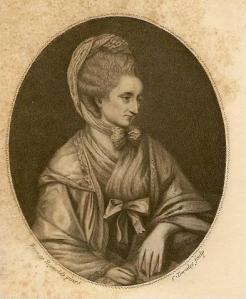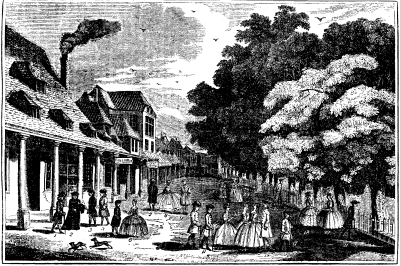1753. Late one Friday night, after a ball in the Public Rooms, a coach and horses turn at high speed into a narrow, poorly lit lane behind the Walks. The footmen are thrown to the ground and the coach topples to one side, close to falling right over. Fortunately there are several people standing nearby who run forward and hold it up while the occupant extricates herself. She is unhurt, but agitated and distinctly unamused.
The lady in question was Elizabeth Montague, who had been a regular visitor to Tunbridge Wells since 1733, when she was 15. Elizabeth was a hypochondriac, who travelled to spas across England in search of a cure for migraines and other ailments. She spent around five weeks each summer in Tunbridge Wells, which was a particular favourite. She described the town’s country air as ‘incomparable.’
Elizabeth was not a great beauty (she had a sharp face and a long nose), did not dress in the latest fashion and was not especially intellectual. But she was vivacious, witty and could speak entertainingly and at length on subjects about which she knew very little. She enjoyed flirting and had many admirers. After she married Edward Montagu, grandson of the second Earl of Sandwich, when she was 24, she had wealth to add to her attractions.
In London Elizabeth became a leading hostess; her friends included writer Samuel Johnson, actor David Garrick and painter Joshua Reynolds. She was also a founder-member of a group of women and men who became known as the ‘blue stocking philosophers’.
Elizabeth was an active letter-writer and often wrote about Tunbridge Wells. She was dismissive of many of the people she met there, who talked ‘of little but water, bread, butter and scandal’. She said that one particular lady ‘looked like a state bed running upon castors; she has robbed the valance and tester of a bed for a trimming’.
Most of Elizabeth’s visits were in the era of Beau Nash. Throughout the summer months Tunbridge Wells was filled with visitors who danced, gambled, gossiped and took the waters. They were a cosmopolitan crowd. French, Germans, Hungarians and Italians mingled with Londoners. Physicians, clergymen, musicians and tradesmen rubbed shoulders with nobility. Elizabeth described the town as the parliament of the world and observed: “Next to some German, whose noble blood might entitle him to be a Grand Master of Malta, sits a pin-makers’ wife from Smock-alley; pickpockets, who are come to the top of their profession, play with noble dukes at brag’. This mixture amused her. ‘I am diverted by the medley;’ she wrote ‘the different characters and figures are amusing, especially at the balls, where persons of every age, size and shape step forth to dance’.
The entertainment on offer was generally not very refined. In one of her letters Elizabeth recalled a concert ‘where the fiddles squeaked, the bass viol grumbled, the trumpets roared, and the bassoon did what is not fit to be mentioned and the musicians, after having stunned us in this manner for two hours, took it ill we desired to be entertained with some country dances’.
 On the whole Elizabeth lived a simpler and quieter life than most visitors, avoiding the ‘busy haunts’ as much as possible and locating herself on Mount Ephraim, well removed from the bustle of the Walks. Her main activity, apart from taking the waters, was making excursions on horseback to places such as Penshurst, Tonbridge and High Rocks.
On the whole Elizabeth lived a simpler and quieter life than most visitors, avoiding the ‘busy haunts’ as much as possible and locating herself on Mount Ephraim, well removed from the bustle of the Walks. Her main activity, apart from taking the waters, was making excursions on horseback to places such as Penshurst, Tonbridge and High Rocks.
Following her coach accident Elizabeth Montagu was shaken and angry. She was in no doubt as to who was responsible and sacked her coachman, who had certainly been drinking and may have been drunk. Elizabeth became the centre of attention for a while and had many enquiries about her wellbeing. The proprietor of the Public Rooms, who was anxious not to lose such a high profile visitor, promised to have the road levelled immediately. However, her experience did not put Elizabeth off Tunbridge Wells and she continued to visit until at least 1879, over 40 years after her first visit.
Notes:
- On most of her visits, Elizabeth stayed at Stone House on Mount Ephraim. Montague Terrace is now on this site.
- Beau Nash, Master of Ceremonies from 1835 onwards, was the subject of an earlier post in Tunbridge Tales.


